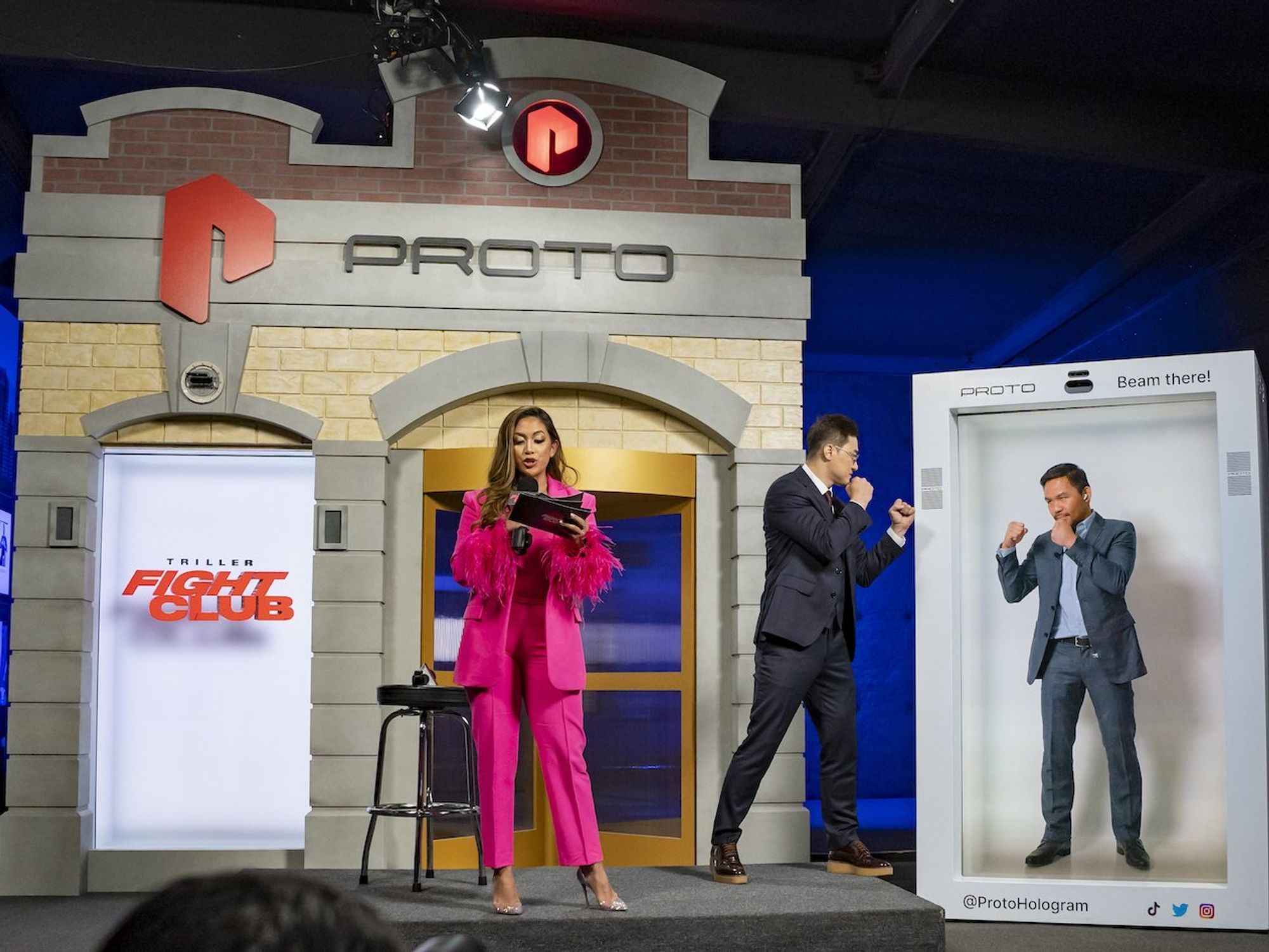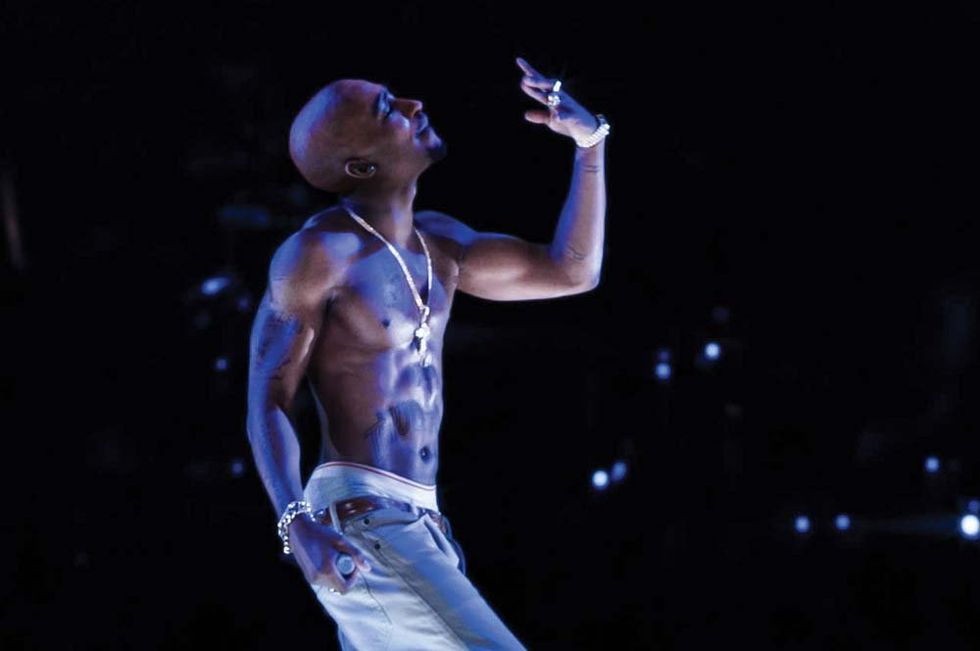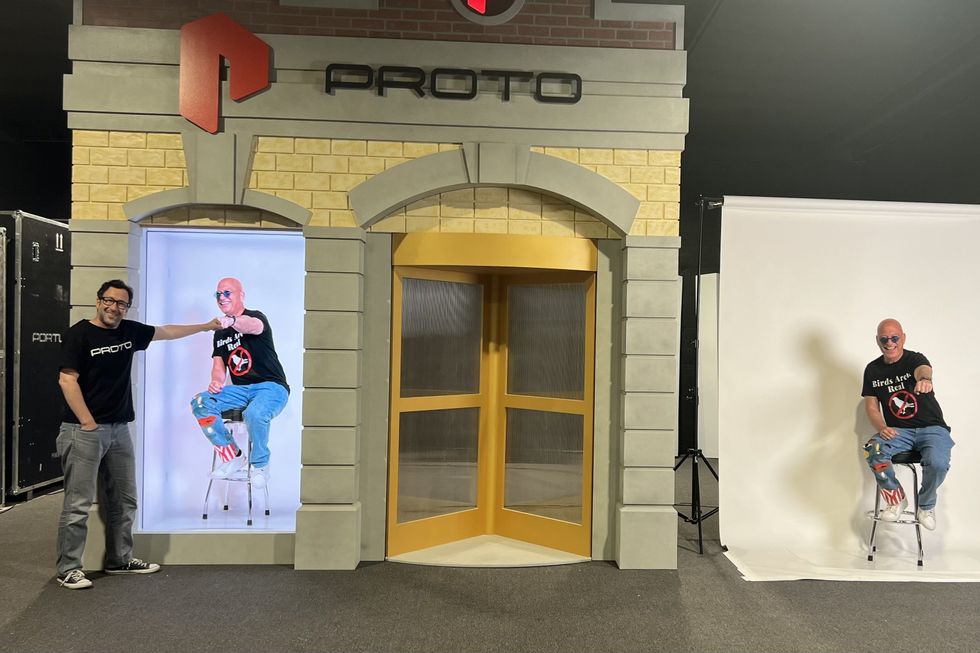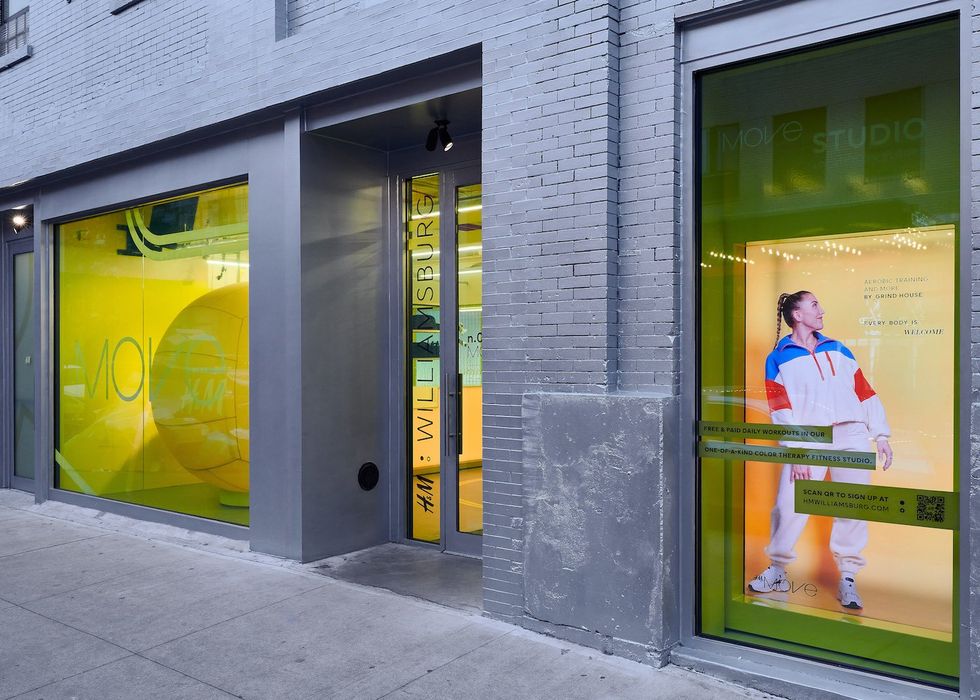Subscribe for free to finish this article!
Join tens of thousands of other founders, investors, and operators who subscribe to dot.LA for the most important tech news in their inbox 2x a week.
Get access to

Get in the KNOW
on LA Startups & Tech
XJoin tens of thousands of other founders, investors, and operators who subscribe to dot.LA for the most important tech news in their inbox 2x a week.
Get access to
Samson Amore is a reporter for dot.LA. He holds a degree in journalism from Emerson College. Send tips or pitches to samsonamore@dot.la and find him on Twitter @Samsonamore.

In 1971, Dennis Gabor was awarded the Nobel Prize in Physics for his invention of the holographic method, which was based on bending light waves to reproduce images. Since then, the hologram’s been adapted for a variety of uses, from reanimating dead musicians to 3-D movies and passport stamps.
During the pandemic as artists worldwide sought out alternative ways to reach their audiences, there was again, a moment in which holograms appeared to be a part of the future – of classrooms, work communication and entertainment.
But the technology is far from mainstream, and the dream that we’d all interact with holograms on a daily basis hasn’t come to fruition yet.
Back in 2012, Tupac Shakur was reanimated for a brief set as a hologram at the Coachella Valley music festival.
The creation was a joint effort between several firms, including Arizona-based AV Concepts and Digital Domain, based in Playa Vista. Digital Domain’s chief technology officer Hanno Basse told dot.LA the company worked with the also King estate and Time Magazine to create a hologram of Dr. Martin Luther King, Jr. for a VR museum exhibit.
Besides holographic people, Digital Domain creates realistic CGI for films in its digital humans lab, and has been used in blockbusters including Marvel’s “She-Hulk,” “Black Widow” and “Avengers: Endgame” as well as a 2018 “Call of Duty” ad for Activision.
Basse said that while Digital Domain’s VFX work with digital humans on films like “Titanic” and “The Curious Case of Benjamin Button” has earned it Oscars, the company’s eager to use its tech in other ventures. Additionally, one area Digital Domain is trying to work more on is video games, which rely entirely on virtual humans. Gaming in particular is a space ripe for virtual human tech, especially since realistically animating characters, especially in multiplayer games, is still challenging even for huge studios.

But while hologram Tupac was a big deal, in 2020, Nussbaum realized that communication – not concerts – was where hologram tech was needed.
So Nussbaum started Proto and developed what’s now the company’s flagship device, the Proto Epic. It’s a nearly 90-inch-tall metal box capable of fitting a human over six feet tall inside. The box is also equipped with front-facing 4K video cameras and speakers, so the box can transmit audience feedback and let the user respond in real-time (watch Ellen DeGeneres do so here).
Becoming a hologram is simple – iPhones 13 and above have 4k cameras, so all it requires is the Proto Beam app, which uses the phone to live capture 3D video and beam it to the Proto E (or the smaller, tabletop model, the Proto M) from anywhere.
You might recall that during the pandemic, news station KTLA used Proto to do remote red-carpet reporting for the 2020 Emmy Awards.
Howie Mandel, a backer of Proto, told dot.LA after a demo he became an investor and advocate for the technology (Proto’s Van Nuys office is housed in the same building as Mandel’s production and podcast studio).
“It was like the first time I saw an iPhone,” Mandel said. “It puts Zoom and every other video broadcaster and hologram company to shame. I can be someplace without going anywhere, which is my dream come true as a germaphobe.”

Mandel said he sees potential for Proto in merchandising. To that end, the company has already inked deals with auction house Christie’s, also an investor, to use Proto devices to show items. Other clients include Verizon, Virgin Media O2 and CAA. Retailer H&M also uses Proto E devices to replace window mannequins.
“I think it’s going to be the Kleenex of communication, retail, education and advertising,” Mandel told dot.LA about his predictions for Proto’s future.
Scott Likens, head of accounting firm PwC’s innovation hub, said he learned of Proto from a participant in its Next Tech Studio and began working with them last spring. PwC mainly uses Proto to communicate globally without boundaries.
“Hologram is a unique space that requires dynamic hardware and software, so we are continuously testing what works in both small and large collaborative sessions,” Likens noted.

Bari Hoffman, associate dean for clinical affairs and internal medicine professor at the University of Central Florida, said she’s been using the Proto Epic device since 2021.
Hoffman said UCF has used Proto to beam in volunteers for virtual exams, including people with advanced Huntington’s disease who couldn’t otherwise travel. She also said Mandel used one to talk to a class about his OCD diagnosis and had a “seamless” live conversation.
“It’s really imperative and impactful for our students to be able to see in high definition the life-size, head to toe experience of that patient,” Hoffman said. She added that while most medical schools also rely on trained actors to simulate symptoms for education, hologram tech could allow people actually living with chronic diseases to volunteer from afar.
But holograms are not ready for large-scale healthcare use, Hoffman said. “Nobody is actually delivering health care with the technology yet, because there's some other things that need to be in place to make it compliant [with regulators].” Adding that, UCF has recruited a “large number of faculty and clinical experts, physicians and surgeons in the community to study and evaluate [it].”

That said, it’s going to take some time before consumer-focused devices like Proto make their way into the home of everyone in America considering the smaller Proto M retails for nearly $7,000. Though Nussbaum wouldn’t disclose sales figures, he said he’s sold “hundreds” of them.
Which explains why other companies have jumped into the hologram business. In 2016, Microsoft began working on HoloLens, a mixed-reality headset that retails for $3,500. And in 2020, Meta filed a patent application for “3D conversations” conducted virtually using hologram-like tech.
For his part, Basse said he expects an arms race for holograms or digital human technology to accelerate. “Visual presentations in one form or another are a major piece of modern life, and people, creators and organizations that are looking to stand out need to find ways to rise above the competition,” he said.
Mandel was also optimistic about holograms becoming mainstream. “This is probably the most excited I have seen people around a piece of technology,” he said of Proto. “It needs to be everywhere.”
Samson Amore is a reporter for dot.LA. He holds a degree in journalism from Emerson College. Send tips or pitches to samsonamore@dot.la and find him on Twitter @Samsonamore.
Samson Amore is a reporter for dot.LA. He holds a degree in journalism from Emerson College. Send tips or pitches to samsonamore@dot.la and find him on Twitter @Samsonamore.
According to a Forbes report last April, both the viewership and dollars behind women’s sports at a collegiate and professional level are growing.
In 2022, the first 32 games of the NCAA tournament had record attendance levels, breaking records set back in 2004, and largely driven by the new and rapidly growing women’s NCAA tournament. WNBA openers this year saw a 21% spike in attendance, with some teams including the LA Sparks reporting triple-digit ticket sales growth, about 121% over 2022’s total. In 2023, the average size of an LA Sparks crowd swelled to 10,396 people, up from 4,701 people.
Women make up half the population, but “also 50% of the folks that are walking into the stadium at Dodger Stadium, or your NFL fans are just about 50% women,” noted Erin Storck, a panelist and senior analyst at Los Angeles-based Elysian Park Ventures.
Storck added that in heterosexual households, women generally manage most of the family’s money, giving them huge purchasing power, a potential advantage for female-run leagues. “There's an untapped revenue opportunity,” she noted.
In the soccer world, Los Angeles-based women’s soccer team Angel City FC has put in the work to become a household name, not just in LA County but across the nation. At an LA Tech Week panel hosted by Athlete Strategies about investing in sports, Angel City head of strategy and chief of staff Kari Fleischauer said that years before launching the women’s National Women’s Soccer League team, Angel City FC was pounding the pavement letting people know about the excitement ladies soccer can bring. She noted community is key, and that fostering a sense of engagement and safety at the team’s home venue, BMO stadium (formerly Banc of California Stadium), is one reason fans keep coming back.
Adding free metro rides to BMO stadium and private rooms for nursing fans to breastfeed or fans on the spectrum to avoid sensory overload, were just some of the ways ACFC tried to include its community in the concept of its stadium, Fleischauer said. She noted, though, that roughly 46% of Angel City fans are “straight white dudes hanging out with their bros.”
“Particularly [on] the woman's side, I'd like to think we do a better job of making sure that there's spaces for everyone,” Fleischauer told the audience. “One thing we realize is accessibility is a huge thing.”
Samson Amore is a reporter for dot.LA. He holds a degree in journalism from Emerson College. Send tips or pitches to samsonamore@dot.la and find him on Twitter @Samsonamore.
L.A. Tech Week has brought venture capitalists, founders and entrepreneurs from around the world to the California coast. With so many tech nerds in one place, it's easy to laugh, joke and reminisce about the future of tech in SoCal.
Here's what people are saying about the fifth day of L.A. Tech Week on social:
#LATechWeek has been on 🔥🔥🔥. Yes the events are super cool at amazing venues. But, I’m blown away by the people. I’ve met so many founders building generative AI companies from the ground up. I’m so bullish on LA right now🥳. LA is for builders #longLA
Thanks @rpnickson 📸 pic.twitter.com/B6rT2jJYIs
— Dr. Kelly O'Brien (@Kvo2013) June 8, 2023
Successful LatinxVC Avanza Summit 2023 in LA! It’s been an amazing few days near the beach w great company. Thank you to our panelists & participants.
Huge thanks to our incredible sponsors SVB, Chavez Family Foundation, Annenberg Foundation, PledgeLA, Fenwick & West, Countsy! pic.twitter.com/oVuGIgFurk
— LatinxVC (@LatinxVCs) June 9, 2023
30+ gaming startups presented at the A16z Speedrun Demo Day in LA yesterday. Great thanks to the @a16zGames team for an awesome day of events! #LATechWeek pic.twitter.com/DKq8IFo5QZ
— Grace Zhou (@graceminzhou) June 9, 2023
📣🤩 What’s the buzz? It’s #LATechWeek from @TechstarsLA & @TechstarsHealth joint demo day with the #Techstar HC team where our @fyelabs founder/CEO Suvojit Ghosh mentored both cohorts! #TechStars demo day highlighted 12 amazing emerging #startups in #healthtech #innovation. 🩺 pic.twitter.com/0RXClCtfDQ
— FYELABS (@fyelabs) June 9, 2023
Another successful Coffee On Slauson in the books for #LATechWeek.
Special thanks to the good people at Pledge LA, SVB and @GundersonLaw for the ongoing support and the @findyourhilltop staff for providing the space, eats & vibes. ♻️ pic.twitter.com/51cMDoEn30
— Slauson & Co. (@SlausonAndCo) June 9, 2023
The perfect combo to start #LATechWeek Day 5: pastries, coffee, and great convos with industry founders ✨
Fireside chats with @enriquealle, @wp, and @robynpark pic.twitter.com/booYPdekVV
— Tech Week (@Techweek_) June 9, 2023
Of course @designerfund has the most amazing pastries at their event. #LATechWeek pic.twitter.com/PjyWlGTQI4
— Jesse Pickard (@jessepickard) June 9, 2023
My favorite event from @Techweek_ has to be "Modern Storytelling & Business Building." Hosted by @STHoward #LATechWeek pic.twitter.com/SV1eexMJ4k
— JonnyZeller (@JonnyZeller) June 9, 2023
And the finale of the night was courtesy of the one and only @zedd for an unforgettable end to the "City of Games" party! Hosted by @a16zGames and @100Thieves #LATechWeek pic.twitter.com/hliI9yLKse
— Tech Week (@Techweek_) June 9, 2023
Excited to be at the @a16zGames Speedrun Demo Day! Loved the energy and excitement from the companies that pitched there. It was also great to see @Tocelot and @ndrewlee at this amazing #LATechWeek event pic.twitter.com/NfLQO5lR27
— Andy Lee | andypwlee.bit (@andypwlee) June 9, 2023
Thank you to everyone who joined the Sony Venture Fund US team at #LATechWeek for our screening of Spider-Man: Across the Spider-Verse. Last summer, we started building a presence in LA. Today, it's exciting to host such an event with the @Sony family and the LA VC community. pic.twitter.com/wdDm6qtHdL
— Sony Innovation Fund (@Sony_Innov_Fund) June 9, 2023
Time to eat, connect and build while @remi_rodney provided the vibes. 🙏🏽#LATechWeek @BuildOnBase @developer_dao @WeAreRazorfish pic.twitter.com/QIPh1gjvoA
— Hola Metaverso-Blockchain & New Web Tech Events 🎪 (@holametaverso) June 9, 2023
@Lux_Capital at #LATechWeek advancing the impossible to inevitable, from..
..defense primes partnering with cutting edge defense tech startups, to..
..hardware x LLMs improving mental health.
From the rich and diverse LA ecosystem stems generational companies: pic.twitter.com/v5S5r8JtbU
— Shahin Farshchi (@Farshchi) June 9, 2023
LA Tech Week has been a blast! Met some amazing creators, founders and investors from all over the world! #LATechWeek pic.twitter.com/AAh9JFELhe
— Chris Germano (@netslayer) June 9, 2023
Had such a blast at LA Tech Week and hosting events for @brexHQ
Top highlights were collabing with @pulley on an Emerging Managers / Founder mixer at the @poplco House, rooftop event in Venice, creator panel with @thechangj & proper Korean food with in KTown.
Exhausted is an… pic.twitter.com/mGQnSYGPdg
— Τyler Robinson (@TyyRob3) June 9, 2023
Did you have fun at @sophiaamoruso’s launch party for @trustfundvc? #LATechWeek pic.twitter.com/gbrbXRQ9Xx
— Kay (@KaySnels) June 9, 2023
y00tilty in every city with @KaylaLor3n & @cryptochrisg813.
Welcome to the LA @y00tsNFT fam! #LATechWeek #3XP week. pic.twitter.com/6wWKlsTacx
— VanG0xH (@CryptoVanGoghs) June 9, 2023
Really enjoyed #LATechWeek. Here are some observations I made 👇
— s.personal.ai (Suman Kanuganti) (@SumanPersonalAI) June 9, 2023
Thank you @TheKofiAmpadu for including me in #demoday with the latest @a16ztxo cohort! It was a real full circle moment to witness the brilliance of both @ChrisLyons & @ZMuse_ & #PledgeLA very own. She’s why we’re #LongLA 🚀💕 #LAtechweek pic.twitter.com/itkKXMxQRb
— Qiana Qiana! (@Q_i_a_n_a) June 9, 2023
@upfrontvc Gaming Founders Podcast #iLOVELA #LATechWeek @Techweek_ @KatiaAmeri @mucker @fikavc @bonfire_vc @TenOne10 @WatertowerGroup @ganasvc @IAmRobRyan @john_at_stonks @eva_ho @dereknorton pic.twitter.com/LCbaGXCoW7
— Sean Goldfaden (@seangoldfaden) June 9, 2023
Hosts Kevin Zhang, Partner at @upfrontvc, and Eden Chen, CEO of @pragmaplatform, interviewed two special guests from @raidbaseinc Stephen Lim, Co-Founder & Product Director, and Trevor Romleski, Co-Founder & Game Director. 🎙 #LATechWeek pic.twitter.com/hxHEAoELZ6
— Tech Week (@Techweek_) June 9, 2023
Kicking off @a16zGames @100Thieves City of Games party at #LATechWeek 🔥🔥🔥 pic.twitter.com/zQcZedG15f
— Jon Lai (@Tocelot) June 9, 2023
Yesterday at @socinnovation I got to have this AWESOME conversation with @iamwill — musician, producer, technology entrepreneur, and Founder & CEO of https://t.co/D60y1e2JOu #LATechWeek pic.twitter.com/KBxK6rXyTG
— Anna Barber (@annawbarber) June 9, 2023
I absolutely love this game. Proud moment for the team @investwithatlas. #LATechWeek pic.twitter.com/fPZvKXU7TC
— Tobias Francis (@TobiasFrancis) June 9, 2023
Had a blast at LA Tech Week this year with @brexHQ
From hosting & moderating my first creator panel featuring @BlakeMichael14, to a fun rooftop night in Venice, and to attending some amazing events such as Watertower’s emerging manager panel and a VC/founder tennis tournament pic.twitter.com/udjfmLHE0L
— Jonathan Chang (@thechangj) June 8, 2023
Samson Amore is a reporter for dot.LA. He holds a degree in journalism from Emerson College. Send tips or pitches to samsonamore@dot.la and find him on Twitter @Samsonamore.
At Lowercarbon Capital’s LA Tech Week event Thursday, the synergy between the region’s aerospace industry and greentech startups was clear.
The event sponsored by Lowercarbon, Climate Draft (and the defunct Silicon Valley Bank’s Climate Technology & Sustainability team) brought together a handful of local startups in Hawthorne not far from LAX, and many of the companies shared DNA with arguably the region’s most famous tech resident: SpaceX.
Here’s a look at the greentech startups that pitched during the Tech Week event, and how they think what they’re building could help solve the climate crisis.
Arbor: Based in El Segundo, this year-old startup is working to convert organic waste into energy and fresh water. At the same time, it also uses biomass carbon removal and storage to remove carbon from the atmosphere and sequester it in an attempt to avoid further damaging the earth’s ozone layer. At the Tech Week event Thursday, Arbor CEO Brad Hartwig told a stunned crowd that Arbor aims to remove about five billion tons of organic waste from landfills and turn that into about 6 PWh, or a quarter of the global electricity need, each year. Hartwig is an alumni of SpaceX; he was a manufacturing engineer on the Crew Dragon engines from 2016-2018 and later a flight test engineer at Kitty Hawk.
Antora: Sunnyvale-based Antora Energy was founded in 2017, making it one of the oldest companies on the pitching block during the event. Backed by investors including the National Science Foundation and Los Angeles-based Overture VC, Antora has raised roughly $57 million to date, most recently a $50 million round last February. Chief operating officer Justin Briggs said Antora’s goal is to modernize and popularize thermal energy storage using ultra-hot carbon. Massive heated carbon blocks can give off thermal energy, which Antora’s proprietary batteries then absorb and store as energy. It’s an ambitious goal, but one the world needs at scale to green its energy footprint. According to Briggs, “the biggest challenge is how can we turn back variable intermittent renewable electricity into something that's reliable and on demand, so we can use it to provide energy to everything we need.”
Arc: Hosting the panel was Arc, an electric boating company that’s gained surprising momentum, moving from design to delivering its first e-boats in just two years of existence. Founded in 2021, the company’s already 70 employees strong and has already sold some of its first e-boats to customers willing to pay the luxury price tag, CTO Ryan Cook said Thursday. Cook said that to meet the power needs of a battery-powered speedboat, the Arc team designed the vehicle around the battery pack with the goal of it being competitive with gas boats when compared to range and cost of gas. But on the pricing side, it’s not cheap. Arc’s flagship vessel, the Arc One is expected to cost roughly $300,000. During the panel, Cook compared the boat to being “like an early Tesla Roadster.” To date Arc Boats has raised just over $35 million, according to PitchBook, from investors including Kevin Durant, Will Smith and Sean “Diddy” Combs.
Clarity Technology: Carbon removal startup Clarity is based in LA and was founded by Yale graduate and CEO Glen Meyerowitz last year. Clarity is working to make “gigaton solutions for gigaton problems.” Their aim? To remove up to 2,000 billion pounds of carbon from the atmosphere through direct air capture, a process which uses massive fans to move chemicals that capture CO2. But the challenge, Meyerowitz noted in his speech, is doing this at scale in a way that makes an actual dent in the planet’s emissions while also efficiently using the electricity needed to do so. Meyerowitz spent nearly five years working as an engineer for SpaceX in Texas, and added he’s looking to transfer those learnings into Clarity.
Parallel Systems: Based in Downtown LA’s Arts District, this startup is building zero-emission rail vehicles that are capable of long-haul journeys otherwise done by a trucking company. The estimated $700 billion trucking industry, Parallel Systems CEO Matt Soule said, is ripe for an overhaul and could benefit from moving some of its goods off-road to electric railcars. According to Soule, Parallel’s electric battery-powered rail vehicles use 25% of the energy a semi truck uses, and at a competitive cost. Funded in part by a February 2022 grant from the U.S. Department of Energy, Parallel Systems has raised about $57 million to date. Its most recent venture funding round was a $49 million Series A led by Santa Monica-based VC Anthos Capital. Local VCs including Riot Ventures and Santa Monica-based Embark Ventures are also backers of Parallel.
Terra Talent: Unlike the rest of the startups pitching at the Tech Week event, Terra Talent was focused on building teams rather than technology. Founder Dolly Singh worked at SpaceX, Oculus and Citadel as a headhunter, and now runs Terra, a talent and advisory firm that helps companies recruit top talent in the greentech space. But, she said, she’s concerned that all the work these startups are doing won’t matter unless we very quickly turn around the current trendlines. “Earth will shake us off like and she will do just fine in 10,000 years,” she said. “It’s our way of living, everything we love is actually here on earth… there’s nothing I love on Mars,” adding that she’s hopeful the startups that pitched during the event will be instrumental in making sure the planet stays habitable for a little while longer.
Samson Amore is a reporter for dot.LA. He holds a degree in journalism from Emerson College. Send tips or pitches to samsonamore@dot.la and find him on Twitter @Samsonamore.